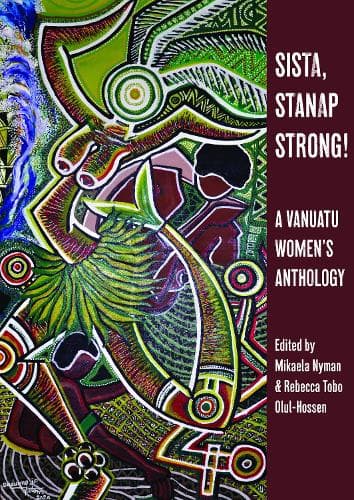Review: Sista Stanap Strong! A Vanuatu Women's Anthology
Reviewed by Selina Tusitala Marsh
I have a “Juliette Pita” displayed on my bookshelf. I bought it in a street market in Port Vila in 2008. I love it. It is a small square canvas painting of women gathered in different states of sitting and standing, watching, listening, talking, with and without children, with and without market bags. They are different shapes and sizes, arrayed in different colours. All are black-skinned and vibrantly clothed. All are strong. All look in the same direction: of womanhood, of their nation.
Pita's now iconic artwork adorns this remarkable first contemporary anthology of Ni-Vanuatu women's stories, poems, essays, memoir and songs. It is only fitting. Both the painting and the book cover convey the rich and dark foliage of creative and critical power embodied and expressed by Ni-Vanuatu women as distinctly voiced individuals and as a powerful group in this anthology.
These writers vary in age, educational and political experience, tribal affiliation and language group. They are homegrown and island-based writers and part of the diaspora living outside of Vanuatu. They tell gripping tales that speak of love of land and of life. Of historical injustices throughout a colonial era beginning with blackbirding (slavery) and military right of rule, to homegrown injustices in ongoing gender inequities and discriminations that limit a woman's right over her body and mind.
These accounts give an insider's insight into what it means to stand at the crossroads of racism and sexism and freeze or lament or give in or get depressed or get angry or get empowered and then to stanup and say: No More. Like the questioning and critiquing of the systemic misogyny that takes away a girl's right to education in Helen Lobanga Tamtam's poem A village girl's place.
Tamtam pushes beyond combative binary gender politics by acknowledging the role men play in addressing this inequity by paying homage to a father who fights for the education of his daughter. Other stories, like Tor's Is it real love? marks the harrowing experience of domestic violence and its seeming inescapability. But in the writing of it, there's a righting of it. The calling out of society's ongoing acceptance of misogyny is a starting point. In the manner of la testimonio, vital witnessings of sexism and discrimination are made public.
But these are more than sole reportage. These are evocative, lyrical pieces of writing. The skillful use of pure and slant rhymes creates a light touched lyricism that juxtaposes the horror of rape and assault in Telstar Jimmy's poem What I remember. Telling the story is the best revenge and an empowering, resilient response to dehumanising treatment. The tight rhyming scheme of the 3 lined stanza poem, Their lives matter more, displays Jimmy's honed ear for rhyme and poetic storytelling.
Other poems explore the evils of sexism while at the same time, offering up a mantra of women's leadership, empowerment, resilience and tenacity, as in Joana Bule's A woman in a man's world: “But I trained myself to be deaf to these negative worlds / To be deaf even to my own negativity.”
Mildred Sope's social history talks of the pain of unfinished books and lost histories in her fascinating interview with Mikaela Nyman, A conversation about poetry and politics, where we gain a glimpse of the kind of connective role women have played in the background of formal political histories – it was Mildred who introduced Father Walter Lini (who would become Independent Vanuatu's first Prime Minister in 1980) to Barak Sope (who would become Prime Minister in 1999). How many more of these stories are yet to find publication?
The reader is in for a sensory feast in this mixed genre anthology. I couldn't put down Caroline Nalo's memoir of her razor-edged adventures when conducting census work in 1967 for the British High Commissioner as she encountered witchcraft, rumored poisoning and the joys of Lux soap after days of bush-trekking. Her journal entries beautifully capture the poetry of the landscape. Nalo possesses an observer's eye with the writer's gift of paying attention as we read of the delicate white orchards of the hillsides “like lilies of the valley for a mouse's wedding bouquet.”
Likewise, the reader is in for an aural treat – to see Bislama on the page, in poem and song, is a call to sound out these words and lean into its linguistic richness. In her poem Bislama, Tamtam personifies the language, bringing critical light to the agency of the often maligned indigenised communal tongue. In doing so, Tamtam gives a poetic nod to the agency Ni-Vanuatu held throughout colonisation. Formed out of necessity in the colonial era to “link people from diverse linguistic backgrounds” from blackbirding days and the days of the bêche-de-mer industry, it was also used to unite people to achieve independence.
I commend and congratulate the editors Mikaela Nyman, Rebecca Tobo Olul-Hossen and the regional editors mentioned in the introduction for their tenacity (through a category 5 cyclone and COVID-19) and their vision to bringing this book alive. Their role as editors, rather than as literary gatekeepers, are more akin to that of midwives, complete with long hours and no pay, who have helped bring new life and new stories into the light of publication.
Sista Stanup Strong! is an anthology full of astute, emotional honest personal declarations and explorations of independence that draw acerbic parallels to Vanuatu's political declarations of independence. As posed in the feminist declarations underpinning the poetry of Vanuatu's first woman poet and politician, Grace Mera Molisa: How can a nation be free while half its citizenry remain colonised? The answer: it cannot. This anthology creatively adds to the numerous declarations of Ni-Vanuatu women's independence. It is, to cite the title of Pita's cover painting, a Viktri Danis, a Victory Dance.
Reviewed by Dr Selina Tusitala Marsh
